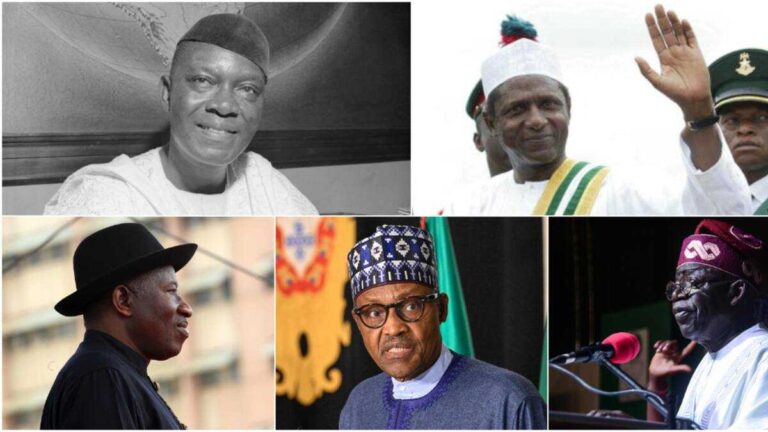Over the last two decades, Nigeria’s federal budgets have painted a troubling picture of escalating expenses, sluggish revenue growth, and a deepening dependence on loans. From Olusegun Obasanjo’s final years in office to Bola Tinubu’s administration in 2025, one pattern remains consistent—spending continues to rise while revenue struggles to keep pace.
2007: Obasanjo’s Era of Borrowing Amid Prosperity
In 2007, President Olusegun Obasanjo unveiled an $18.3 billion national budget, supported by projected revenues of $13.3 billion and a $5 billion borrowing plan—about 27% of the total budget. This came at a time when Nigeria was still enjoying the fiscal breathing space provided by the massive 2005 debt relief, which eliminated approximately $30 billion in external debt.
With oil prices soaring and economic growth hovering above 6%, Nigeria’s outlook seemed promising. However, even then, external loans were necessary to drive critical infrastructure and social investments.
2015: Jonathan’s Expansion in a Turbulent Economy
Fast-forward to 2015, under President Goodluck Jonathan, the budget had expanded to $22 billion. However, declining oil prices revealed cracks in Nigeria’s economic structure. Despite the downturn, the government borrowed $9 billion—41% of the budget—to meet its spending demands.
As oil revenues plummeted, recurrent expenditures such as subsidies and public sector wages continued to climb, stretching the budget and swelling the national debt. It marked the beginning of Nigeria’s fiscal instability.
2023: Buhari’s Debt-Driven Mega Spending
By 2023, during President Muhammadu Buhari’s final year, Nigeria’s budget had ballooned to $47.39 billion. However, with revenues still lagging at $22 billion, the government turned to massive borrowing—$25 billion, accounting for 53% of the total budget.
To finance rising costs in infrastructure, social programs, and security, the Central Bank intensified Ways and Means advances (essentially printing money), which contributed to soaring inflation levels—the highest in nearly two decades. By the end of Buhari’s tenure, Nigeria’s debt had crossed $100 billion, and debt servicing consumed as much as 33.82% of national income at certain points.
2025: Tinubu’s Budget Hints at Fiscal Discipline
President Bola Tinubu’s proposed 2025 budget totals $36.8 billion—marking a significant drop from Buhari’s previous outlays. Borrowing is projected at $8.98 billion (24% of the budget), while the government aims to generate $24.38 billion in revenue, thanks to reforms like fuel subsidy removal and exchange rate unification.
While the budget appears more restrained, significant hurdles persist:
-
Revenue Assumptions: The projected revenue is optimistic. Oil production remains underwhelming, and the tax collection system remains weak and inefficient.
-
Debt Burden: Though borrowing is reduced, existing debt remains a heavy load. If revenues fall short, debt servicing could still destabilize the budget.
-
Legislative Risks: The National Assembly often adjusts budgets with additional spending. Without matching revenue, this could reverse gains.
Structural Flaws Underpinning the Crisis
Beyond the numbers, Nigeria’s budgeting woes reflect deeper systemic issues:
-
Oil Reliance: Despite diversification efforts, crude oil still accounts for over 60% of government revenue. Market volatility poses ongoing risks.
-
Low Tax Efficiency: Nigeria’s tax-to-GDP ratio remains at a meager 6-8%, among the lowest globally. Tax loopholes and widespread evasion erode collections.
-
Overwhelming Recurrent Expenditures: A large portion of the budget goes to salaries, pensions, and debt payments—leaving little room for developmental projects.
Path to Stability: What Must Be Done
To escape a looming debt crisis and establish a more resilient fiscal path, Nigeria needs bold reforms:
-
Diversify Revenue Streams: Expanding VAT, property taxes, and digital economy taxes can reduce oil dependency.
-
Eliminate Waste: Consolidating government agencies and cutting governance costs could unlock vital savings.
-
Channel Funds into Growth Areas: Strategic investment in power, transportation, and agriculture will fuel long-term economic gains.
Conclusion: A Defining Moment
From 2007 to 2025, Nigeria’s budgets tell a cautionary tale—government spending has outpaced income, leading to repeated borrowing and mounting debt. Tinubu’s 2025 budget offers a glimmer of discipline, but execution remains key. Without decisive and sustained reforms, Nigeria risks falling deeper into a fiscal trap that could stifle development and economic freedom for years to come.

